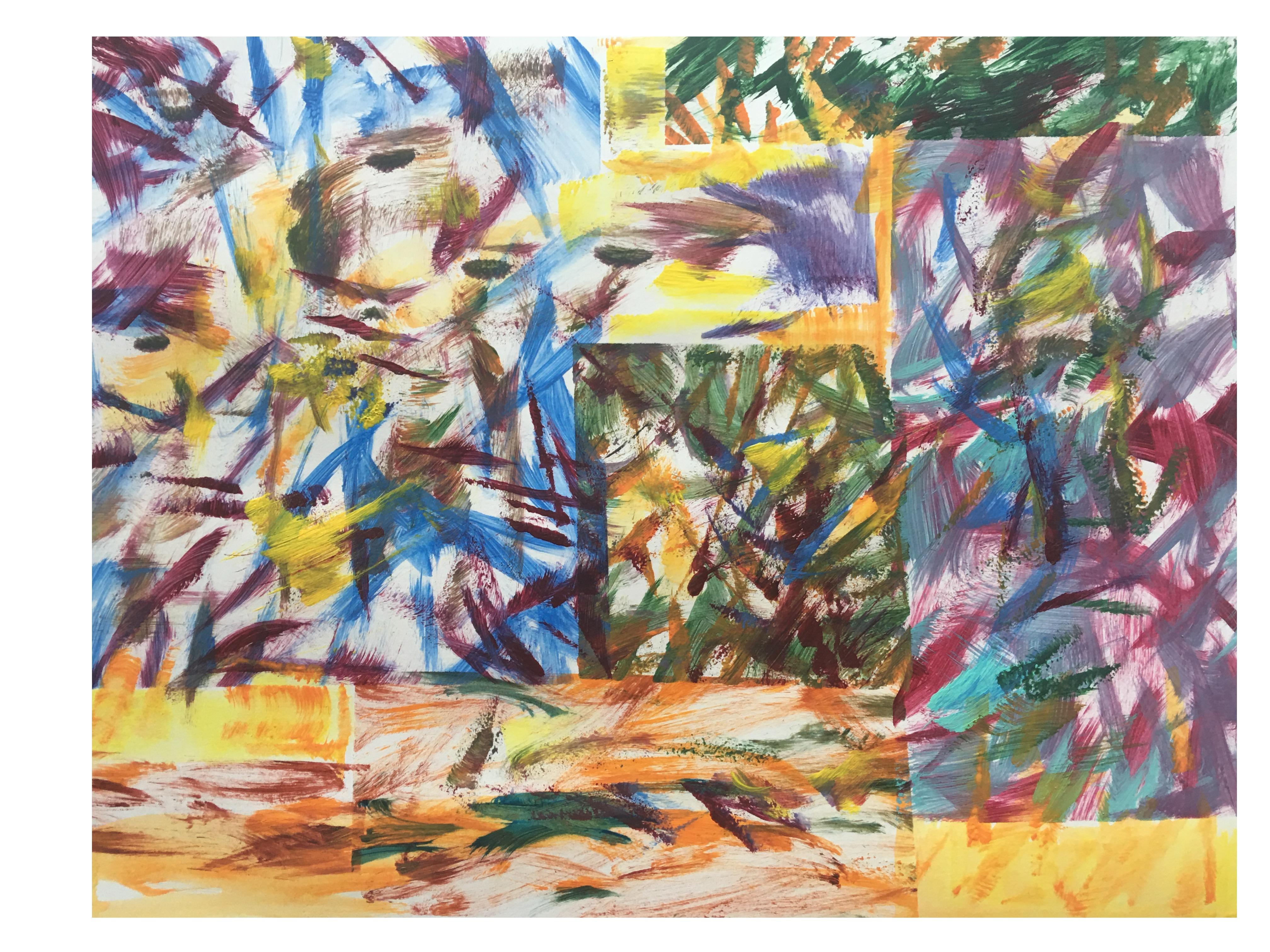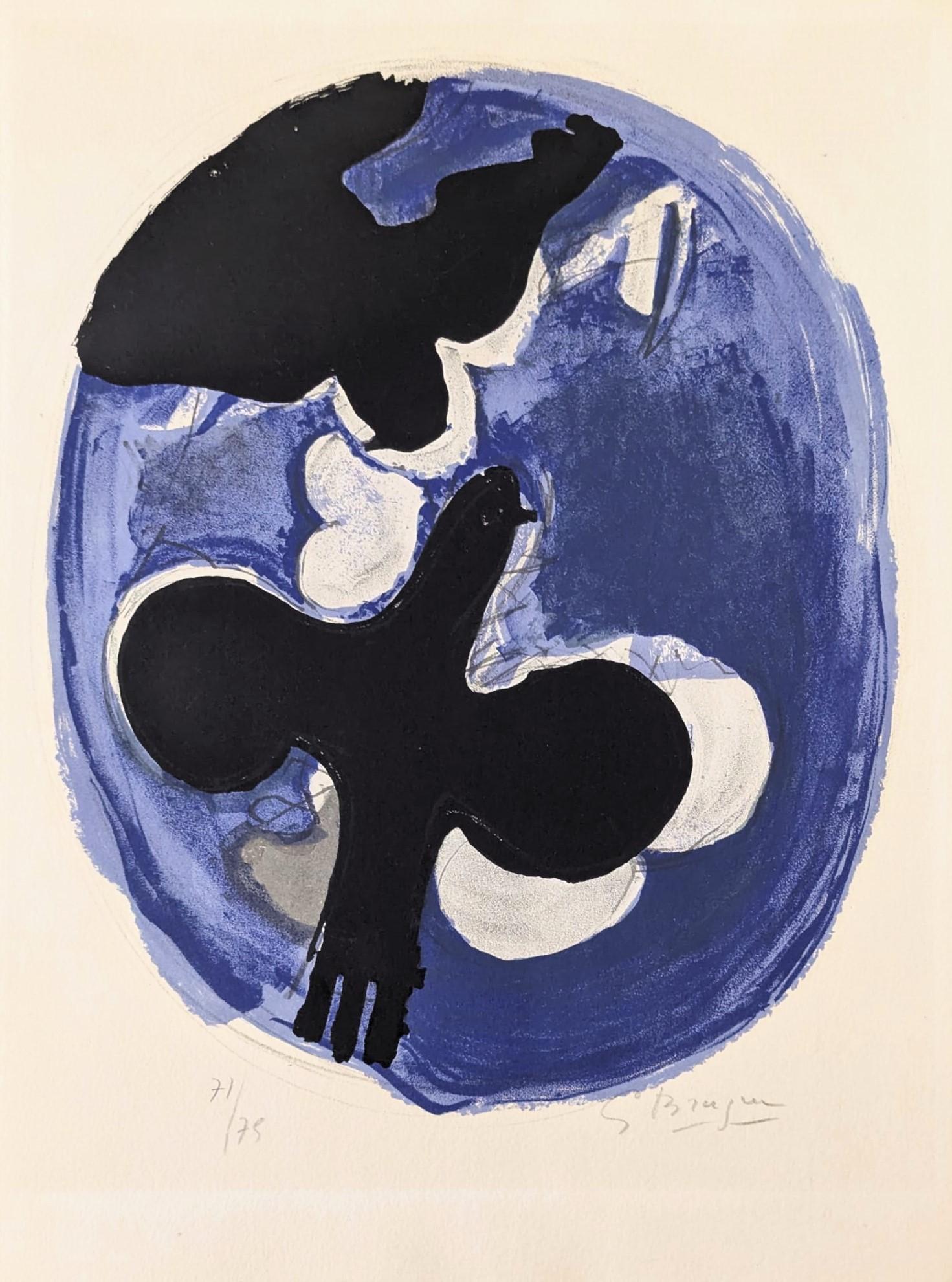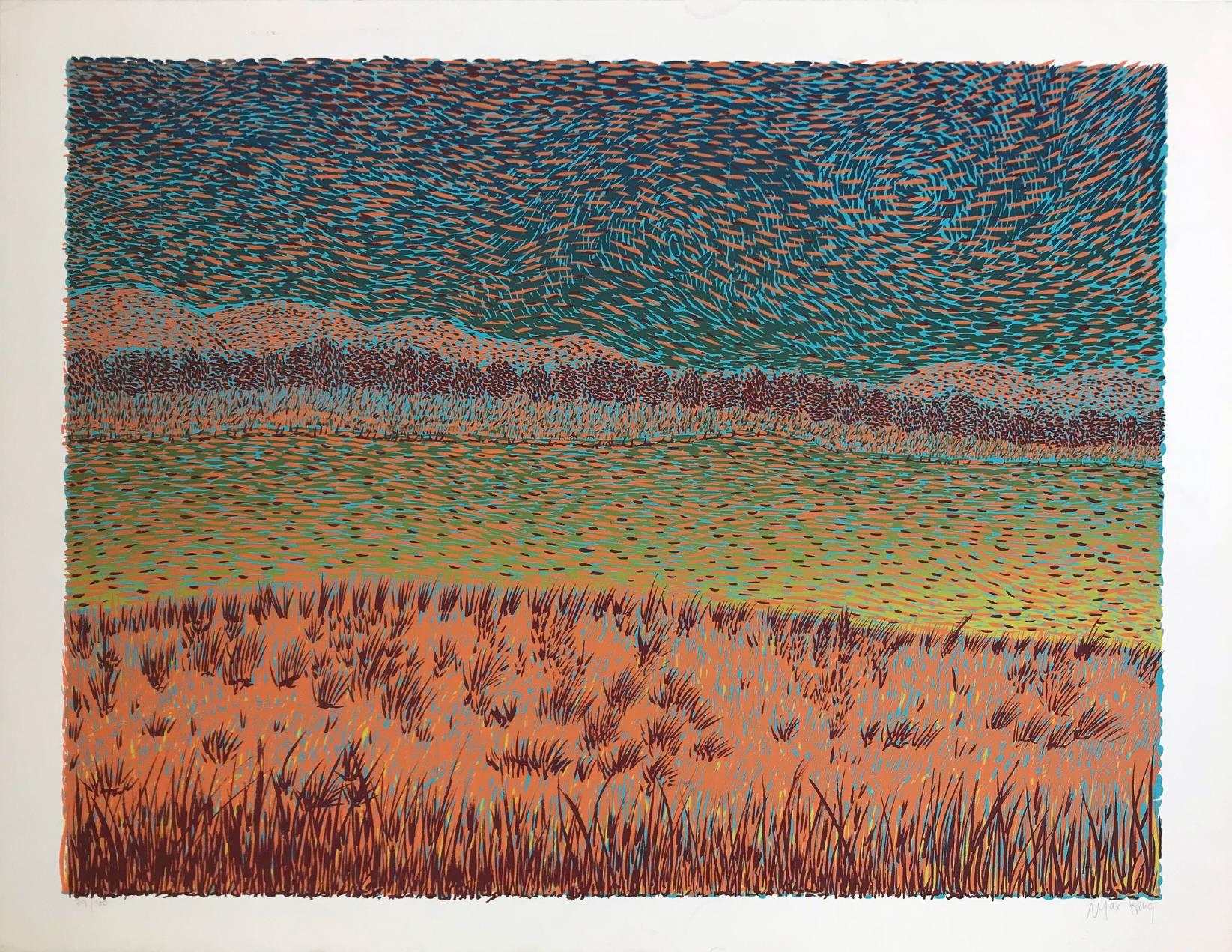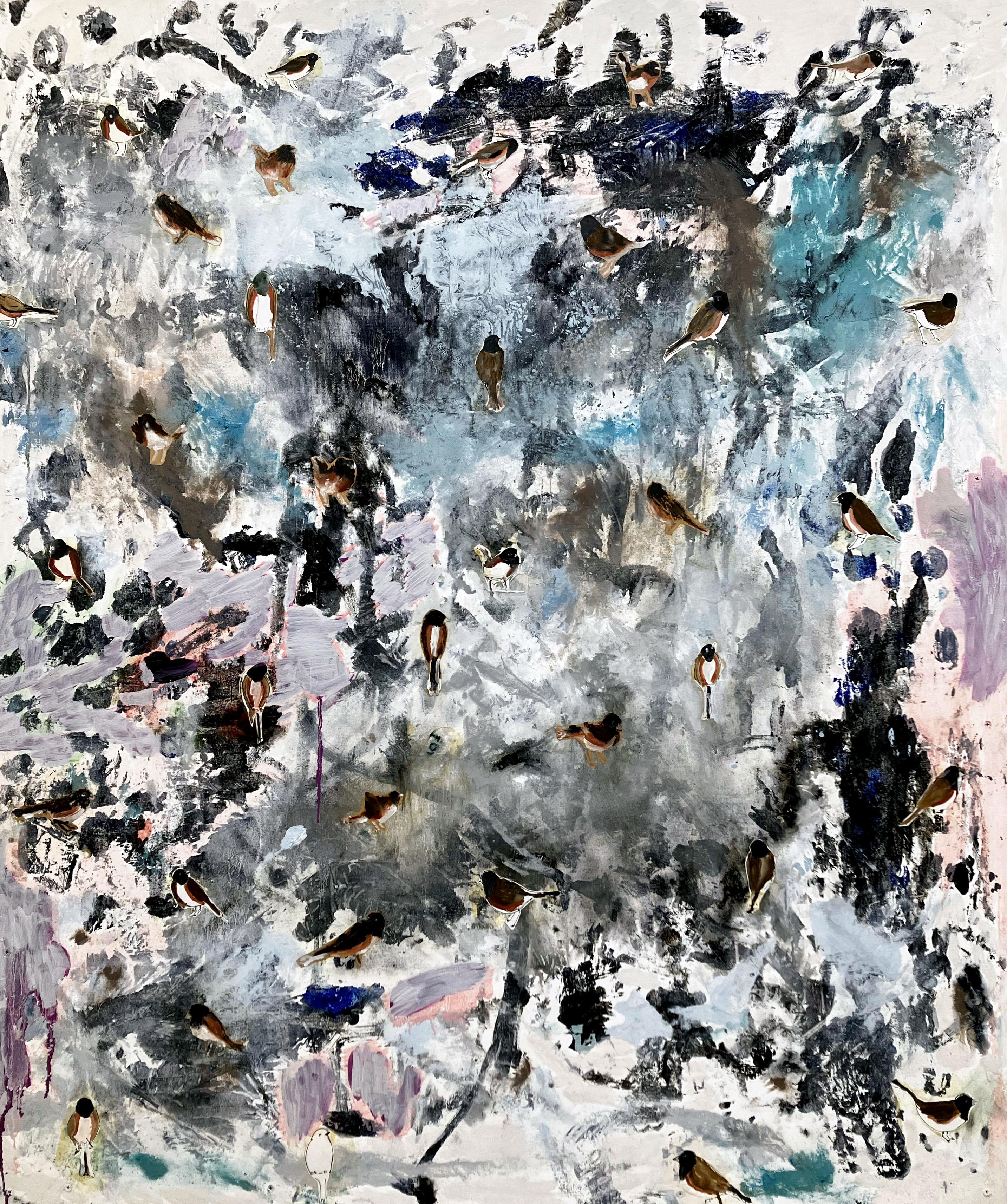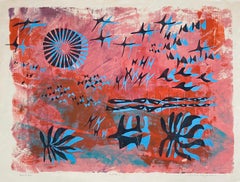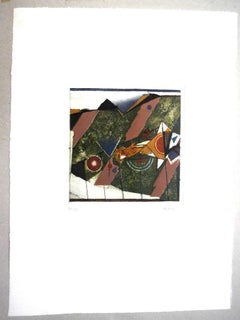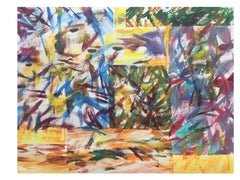Items Similar to Flight of Sea-Birds: Twilight
Want more images or videos?
Request additional images or videos from the seller
1 of 11
UnknownFlight of Sea-Birds: Twilight
$850
£643.87
€742.85
CA$1,191.80
A$1,328.54
CHF 699.26
MX$16,105.63
NOK 8,902.87
SEK 8,277.51
DKK 5,544.46
About the Item
Silkscreen on paper. with some sort of experimental poured stuff on it. there is some loss to the margin but the image is strong. edition 2/6.
During the 1930s, Lawrence Edward Kupferman was employed by the WPA Works Progress Administration, making a series of etchings and dry points, mostly of the facades of houses. His style changed completely in the 1940s, becoming first political and expressionist, and later abstract expressionist.
He served as chairman of the department of painting at the Massachusetts College of Arts.He studied at the Boston Museum School with Philip Leslie Hale and H. Alden Ripley (1929-1931); Massachusetts School of Art with Ernest L. Majors and Otis Philbrick (1931-1935). Kupferman took motifs from tangible and sensed realities. His atmospheres symbolize cosmic space. Existence is spiritualized as a connected covenant with all of creation. Veil-like, mysterious lines move like vapors over washes of opaque translucent colors that blend, erupt or fade into seas of time-like space and souls become one with an ever-moving, deepening milieu.
He admitted, "My figures journey to greet an eternal fellowship with nature’s every particle. . . .
"Around 1941, I started to pour paint onto canvases in Provincetown. Jackson Pollock came into my studio to observe how I let paint take on a liquid life or path of its own. Those ethereal poured paintings may have stimulated Pollock's more frantic splashed-on techniques” Kupferman said thoughtfully.Some critics gave him credit for having been one of the pioneering fathers of the poured painting technique. As early as 1943, the Museum of Modern Art, the Whitney Museum of American Art and various publications acknowledged him as a humanistic innovator whose work bluntly exposes humans to themselves. Kupferman, Jack Levine (b. 1915), Hyman Bloom (b. 1913) and David Aronson (b. 1923) founded the "The Boston Urban Jewish School," whose roots ran deep into traditional Hebraic scholarship."Throughout my career," Kupferman admitted, "Boston was a mental and physical prison in which genuineness and spontaneity in art was absent. I summered in Provincetown for artistic sanity. Mark Rothko, Hans Hofmann, Adolph Gottlieb, William Baziotes, Leo Manzu, Byron Brown and I hung out together in an invigorating atmosphere of rediscovery. We started our own renaissance! Together with Robert Motherwell, Richard Pousette-Dart, Weldon Kees and Karl Knath, we exhibited at Forum 49.
He was a member of the Society of American Etchers; Associate at the National Academy; and Philadelphia Watercolor Club. Award recognition came from American Artists for Victory (1942); San Francisco Art Association (1938); and Society of American Etchers (1939).
One-man shows include Mortimer Brandt Gallery (1946); Boris Mirski Gallery, Boston (1944-1946); Mortimer Leavitt Gallery, NY (1948, 1949, 1951, 1953); Martha Jackson Gallery (1955); Swetzoff Gallery, Boston (1956); Ruth White Gallery, NY (1958); Gropper Gallery, NY (1958); Pace Gallery, Boston (1950,1961,1963); DeCordova Museum, Lincoln, MA (1961); Galerie Irla Kert, Montreal (1962); Art Unlimited, Prov., RI (1963); Tragos Gallery, Boston (1965); Horizon Gallery, Rockport (1968); Greenfield Gallery, NY (1970); Horizon West, L.A., CA (1971); Harold Ernst Gallery, Boston (1973);retrospective, Brockton Art Museum, Brockton, MA (1976).
Kupferman was an instructor at the Massachusetts School of Art (1941-1970).
He was married to artist Ruth Cobb.
- Dimensions:Height: 20 in (50.8 cm)Width: 25.5 in (64.77 cm)
- Medium:
- Movement & Style:
- Period:
- Condition:there is some loss to the margin. it can be laid down on paper. there is also some clear poured material on the surface of the piece giving it a texture. there is also some toning and staining in the margins. please see photos.
- Gallery Location:Surfside, FL
- Reference Number:1stDibs: LU38216751252
About the Seller
4.9
Platinum Seller
Premium sellers with a 4.7+ rating and 24-hour response times
Established in 1995
1stDibs seller since 2014
1,792 sales on 1stDibs
Typical response time: <1 hour
- ShippingRetrieving quote...Shipping from: Surfside, FL
- Return Policy
Authenticity Guarantee
In the unlikely event there’s an issue with an item’s authenticity, contact us within 1 year for a full refund. DetailsMoney-Back Guarantee
If your item is not as described, is damaged in transit, or does not arrive, contact us within 7 days for a full refund. Details24-Hour Cancellation
You have a 24-hour grace period in which to reconsider your purchase, with no questions asked.Vetted Professional Sellers
Our world-class sellers must adhere to strict standards for service and quality, maintaining the integrity of our listings.Price-Match Guarantee
If you find that a seller listed the same item for a lower price elsewhere, we’ll match it.Trusted Global Delivery
Our best-in-class carrier network provides specialized shipping options worldwide, including custom delivery.More From This Seller
View AllBlack Sun
By Lawrence Kupferman
Located in Surfside, FL
Silkscreen on paper. with some sort of experimental poured stuff on it. there is some loss to the margin but the image is strong. edition 2/6.
During the 1930s, Lawrence Edward Kupferman was employed by the WPA Works Progress Administration, making a series of etchings and dry points, mostly of the facades of houses. His style changed completely in the 1940s, becoming first political and expressionist, and later abstract expressionist.
He served as chairman of the department of painting at the Massachusetts College of Arts.He studied at the Boston Museum School with Philip Leslie Hale and H. Alden Ripley (1929-1931); Massachusetts School of Art with Ernest L. Majors and Otis Philbrick (1931-1935). Kupferman took motifs from tangible and sensed realities. His atmospheres symbolize cosmic space. Existence is spiritualized as a connected covenant with all of creation. Veil-like, mysterious lines move like vapors over washes of opaque translucent colors that blend, erupt or fade into seas of time-like space and souls become one with an ever-moving, deepening milieu.
He admitted, "My figures journey to greet an eternal fellowship with nature’s every particle. . . .
"Around 1941, I started to pour paint onto canvases in Provincetown. Jackson Pollock came into my studio to observe how I let paint take on a liquid life or path of its own. Those ethereal poured paintings may have stimulated Pollock's more frantic splashed-on techniques” Kupferman said thoughtfully.Some critics gave him credit for having been one of the pioneering fathers of the poured painting technique. As early as 1943, the Museum of Modern Art, the Whitney Museum of American Art and various publications acknowledged him as a humanistic innovator whose work bluntly exposes humans to themselves. Kupferman, Jack Levine (b. 1915), Hyman Bloom (b. 1913) and David Aronson (b. 1923) founded the "The Boston Urban Jewish School," whose roots ran deep into traditional Hebraic scholarship."Throughout my career," Kupferman admitted, "Boston was a mental and physical prison in which genuineness and spontaneity in art was absent. I summered in Provincetown for artistic sanity. Mark Rothko, Hans Hofmann, Adolph Gottlieb, William Baziotes, Leo Manzu, Byron Brown and I hung out together in an invigorating atmosphere of rediscovery. We started our own renaissance! Together with Robert Motherwell, Richard Pousette-Dart, Weldon Kees...
Category
20th Century Modern Abstract Prints
Materials
Paper
Untitled Abstract
Located in Surfside, FL
etching & aquatint (hand-signed in English and numbered in pencil. Ed 99)
Paper size: 15X11 inches
Image size: 6X6 inches
Condition: work is in excellent condition and is...
Category
20th Century Abstract Abstract Prints
Materials
Etching, Aquatint
Bird & Young
By Joseph Domjan
Located in Surfside, FL
Born in Budapest in 1907, he had a humble upbringing and a passion for the arts. Shortly after the Hungarian Revolution broke out in 1956, Domján was invited to showcase his work in New York; given both the circumstances and opportunities, he readily accepted. Eventually, with his wife and children, he settled in Tuxedo Park. Here, he established the Domján Studio and where lived until his passing in 1992. In his early years, and during the Great Depression, Domján toured Europe with the desire to be engulfed by art. Previously, much of his time had been consumed with the work of both an engine fitter and foundry worker. After testing the waters of over 20 different professions, he discovered his passion in the arts. Later, during his European tour, he earned his way by selling a variety of works including both paintings and sketches. Post-depression, he returned to Hungry where he studied seven years at the Budapest Academy of Arts.
Having spent an earlier portion of his life as a painter, Domján created his first woodcut in 1947 by using oil paint as opposed to printer’s ink. The result was stunning. This technique, becoming his signature style, would later set him apart from others within the trade. To create his pieces, Domján applied rich color, layer by layer, and lays claim to having “succeeded in bringing to the world something that had not existed before.”
Ultimately, each print became three dimensional and gave the appearance of a painting. His technique has gained him international merit as well as the honor of receiving China’s “Master of the Color Wooodcut” award, a recognition given only once every century. The inspiration behind many of Domján’s woodcuts, coupled with his love of nature, is derived from Hungary’s brilliant folklore. The intricacy of his design is certainly his prominent element; however, their subtle coloring and abstract images contribute to his
unique style.
For the 59th Anniversary of composer Béla Bartók’s opera, Duke Bluebeard’s Castle, Domján used the opera’s profound imagery to create a series of woodcuts. The work included an ominous castle, coiled snakes, smirking masks, elusive zodiac symbols, and the story’s forbidden key. In doing so, Domján was able to weave traditional folklore components into a fantastic piece of modernized art. His work is not only expressive of Hungarian folklore...
Category
20th Century Landscape Prints
Materials
Mixed Media, Wood Panel
Untitled
By Nissan Engel
Located in Surfside, FL
Participation in salons:
Grand Prix International de Peinture, Cannes, France 1958
Jeune peinture, Paris, France 1960-65
Grands et jeunes d'aujourd'hui, France 1960-85
des Beaux-Arts, Paris, France 1960-65
Comparaisons, Paris, France 1980
de Montrouge, France 1980-83
Nissan Engel's works are found in numerous private and
public collections, including the following:
Abright-Knox Museum, Buffalo, New York
Bridgeston Museum, Tokyo
The Detroit Institute of Arts, Detroit, Michigan
Elf Atochem Corporation, Paris
Fresno Art Museum, Fresno, California
The Jewish Museum, New York City
Muscarelle Museum of Art, Williamsburg, Virginia
Neuberger Museum of Art, State University of New York at
Purchase
Schlumberger Foundation, Paris
Weizman Institute, Rehovot, Israel
Nissan Engel graduated from the Beaux-Arts Bezalel in Jerusalem before receiving a diploma from the Centre Dramatic de L'Est in Strasbourg, France. He began his career designing costumes and sets for the theater in Paris. Engel moved to New York City in 1965 following a series of successful gallery exhibitions. His early work in Paris and New York was characteristic of his academic training and his subject matter was predominately figural and representational. He returned to Paris in 1975, and inspired by a flea market find of old sheet music...
Category
20th Century Modern Landscape Prints
Materials
Lithograph
"Untitled"
By Tom Baldwin
Located in Surfside, FL
Recently graduated from Pasadena’s legendary Art Center College of Design, Tom Baldwin created the series of inkjet prints Japanese Gardens in 1996 on his computer, using then-nascent graphics technology to "paint" his images on the computer screen. Baldwin embraced this technology and its accompanying printing process not just for the speed and ease of their use, but because the artist could achieve the absolute flatness that the principles of modernism preached but ultimately--because of the limitations of their tools--never reached. These colorful, semi-abstracted views of Japanese temple landscapes subtly, but radically redefine picture space. Baldwin shifts fore and backgrounds, giving equal weight to skies and hillsides. Endowing a lowly bush with a vibrant purple or orange might cause it to pop out of proportion, but ultimately lends balance and stability to the work itself, in short, returning the composition to its original, harmonious whole in keeping with the subject matter. these original prints employ a color scheme that seems more reminiscent of 1980s Japanese pop art beer advertisements...
Category
20th Century Abstract Prints
Materials
Screen
Listen to a Seashell
Located in Surfside, FL
An Abstract Expressionist vibrant colorful painting from 1970. signed illegibly verso with an original price tag of 2200$ from 1970. Highly textured.
Category
1970s Abstract Expressionist Abstract Paintings
Materials
Acrylic
You May Also Like
Birds in Flight
Located in Buffalo, NY
A modern Chinese watercolor painting depicting birds soaring under a red sun.
Category
1970s Modern Figurative Paintings
Materials
Archival Ink, Archival Paper, Watercolor
$1,100 Sale Price
38% Off
Untitled, Two Birds
By Ruth Leaf
Located in San Francisco, CA
This artwork "Untitled, Two Birds" 1991, is an original woodcut monoprint on artisanal hand made paper by noted American artist Ruth Leaf, 1923-2015. It is hand signed and dated in r...
Category
Late 20th Century Abstract Expressionist Abstract Prints
Materials
Monoprint
And The Birds Sang
By Don Wunderlee
Located in Boston, MA
Artist Commentary:
The language of form and color, the tools of abstract painting provide unlimited potential to express poetic ideas. Often a visual idea can have its roots in an a...
Category
21st Century and Contemporary Abstract Abstract Paintings
Materials
Paper, Acrylic
Birds - Studies for the Louvre ceiling
By Georges Braque
Located in Paris, FR
Lithograph, 1955
After Georges Braque
Handsigned by the artist in pencil and numbered 71/75
Publisher : Verve (Paris)
Printer : Mourlot (Paris)
38.00 cm. x 26.00 cm. 14.96 in. x 10....
Category
1950s Abstract Abstract Prints
Materials
Lithograph
Untitled
Located in New York, NY
Artist Unidentified /Unknown, "Untitled" Edition 79 /100, 19.75 x 25.50, Late 20th Century
Colors: Purple, Blue, Brown, Yellow, Turquoise, Pink
Note* Unidentified Artist s...
Category
Late 20th Century Abstract Landscape Prints
Materials
Lithograph
Final Birds
By C. Dimitri
Located in Brooklyn, NY
Oil paint and oil on paper mounted on wood panel. Mostly monochromatic gestural abstraction with multiple bird images.
Category
2010s Abstract Abstract Paintings
Materials
Mixed Media, Oil, Wood Panel
